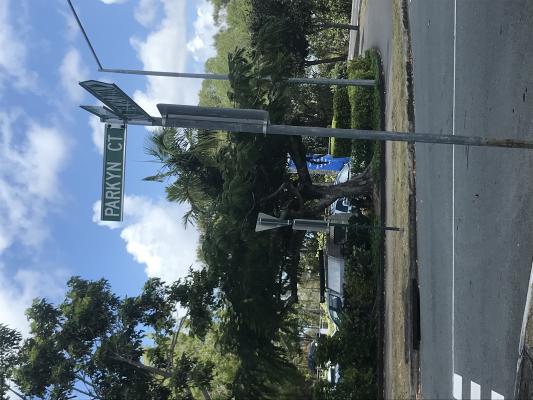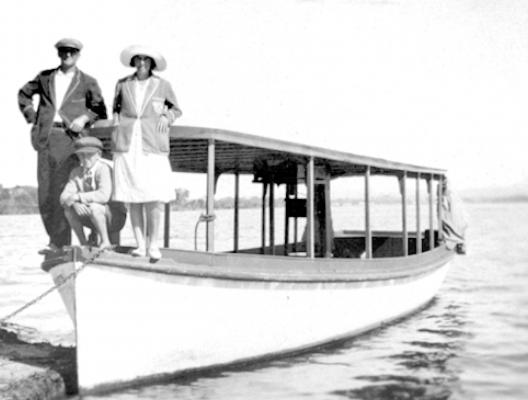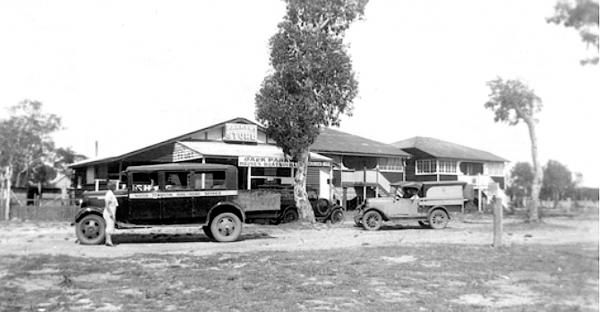Considering the fact that you could write a book about the Parkyn family’s contributions to Noosa’s pioneer days of river transport and tourism, Parkyn Court’s couple of hundred metres doesn’t quite seem adequate.
On the other hand, leading to the Noosa Marina ferry terminal and right next to the site of the old Parkyn wharf, it is an appropriate memorial.
The Parkyn Noosa story began in 1880, when patriarch Richard, a Gympie mining manager, built one of the first holiday homes on the riverfront at what would become Gympie Terrace, naming it “Shearston”. Richard’s son’s Jack grew up fishing and swimming in the Noosa River, and in the early 1900s, built up a successful ferry service and fishing operation with his boat, the Miss Tewantin. In the years after World War I, the Parkyns and the Massouds, with their boat, the Riverlight, enjoyed a fierce but friendly rivalry to see who would rule the river.
By the 1920s, Jack Parkyn and his young sons, Howard and Cloudsley, had a lock on the early tourism trade. In addition to having the main fishing wharf at Tewantin and leasing the riverfront at Munna Point as a campground, it was the Parkyns who got the better of the trade in arrivals for Noosa Heads, particularly after the Donovan family took over the license for the Royal Mail Hotel. Young Lionel Donovan would pick up the tourists from the train at Cooroy in his latest gleaming Tourer, drive them to Tewantin for a refreshing drink or an overnight stay at the Mail, then hand them on to the Parkyns who would motor them down the river to the Noosa inlet in the Miss Tewantin, signing them up for fishing excursions as they went, and carry their bags along the sandy track to the Donovans’ Laguna House.
The building of two new bridges and proper road access to Noosa Heads in 1929 meant that Jack Parkyn, the Massoud brothers, and the other part-time ferrymen all had to rethink their business models, but it was the Parkyns who really capitalised on the new motor tourism.
Long before the Doonella Bridge was a reality, Jack Parkyn and his sons had begun to develop their land at Munna Point into a humble, yet futuristic, integrated resort that he knew would appeal to touring motorists, as soon as they could access it. The family cleared a paperbark forest from the rear of the property, stripped back the undergrowth from the rest of it, in the hope of eliminating the dreaded midges and sandflies (they didn’t), and created level campsites facing the river up as far as the track that would become Russell Street. Here they built a row of timber holiday cottages and a general store.
In the summer of 1929, as the ferry business went west while motorists went east across the bridges, they were ready to introduce visitors to the most advanced caravan and campground on the entire North Coast.
Although he was more or less retired by 1940, Jack Parkyn found himself at the centre of Tewantin’s mysterious pub fires. This strange sequence of events began in March 1939 when the Royal Mail burnt to the ground, having recently been sold by Eliza Donovan to the Bulimba Brewery Co, which used the insurance money to build a brick replacement. Exactly a year later the only other pub in town, Martin’s Tewantin Hotel, which had also been sold to Bulimba a few months earlier, burnt to the ground.
Unlike the Mail, Martin’s had a handful of guests whose lives were saved in the middle of the night when neighbour Jack Parkyn sounded the alarm and ran from door to door with the licensees alerting people. Old Jack was the hero of the day, but the jury is still out on the Bulimba Brewing Co (later Queensland Brewery), which elected not to rebuild Martin’s, thereby giving itself a monopoly on beer sales for the town.









